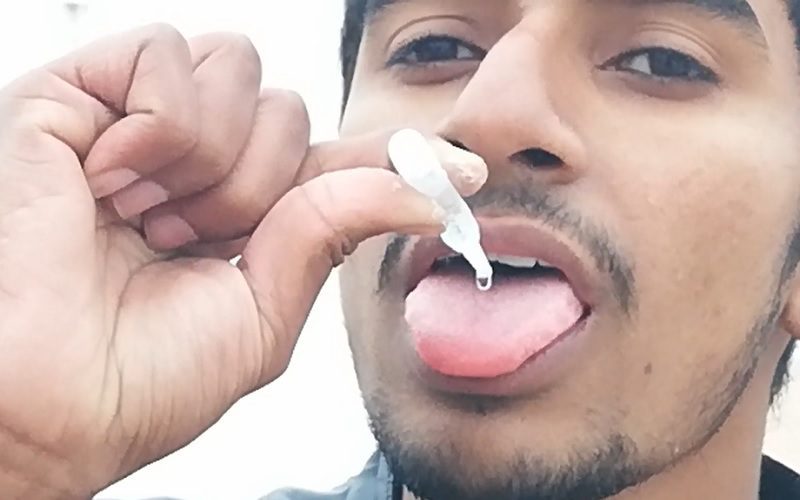Views: 46
Eating glue can lead to stomach discomfort and potential blockages in the digestive system. Glue is not meant for consumption and can be harmful if ingested.
Ingesting glue may cause nausea, vomiting, and abdominal pain. It is essential to seek medical attention if glue is accidentally consumed to prevent any adverse effects on your health.
Remember to keep adhesives out of reach of children to avoid accidental ingestion incidents. Always use glue for its intended purpose and handle it with care to prevent any mishaps that could jeopardize your well-being.
Contents
The Sticky Truth
When it comes to the sticky truth about glue, many people wonder what happens if you eat it. Let’s explore the types of glue, common ingredients, and the potential effects of ingesting this household adhesive.
Types Of Glue
Glues come in various forms, each designed for specific materials and applications. The most common types include:
- Epoxy glue
- School glue
- Super glue
- Wood glue
- Construction adhesive
Common Ingredients
Glues contain different ingredients depending on their intended use. However, some common components found in many adhesives include:
- Polyvinyl acetate (PVA)
- Resins
- Solvents
- Plasticizers
Accidental Ingestion Vs. Intentional Consumption
Accidental ingestion occurs when glue is unintentionally consumed, often by children. It can lead to digestive discomfort, nausea, and possible blockages in the digestive system.
On the other hand, intentional consumption of glue can result in more severe consequences, such as chemical poisoning and damage to internal organs.
It is important to keep glue and other potentially harmful substances out of reach to prevent accidents. Accidental Ingestion vs. Intentional Consumption Children and Glue Eating It’s not uncommon for children to be curious and accidentally ingest glue or intentionally consume it, mistaking it for food due to its appearance.
Accidental ingestion can occur when young children mistake glue for food or candy, while intentional consumption may happen when older children or teenagers misuse glue for its mind-altering effects.
The Attraction to Non-Food Items Children are naturally curious, and their exploration of the world around them can lead to accidental ingestion of non-food items.
The colorful and often sweet-smelling nature of some glues can be attractive to young children, leading them to mistake it for food or candy.
In the case of intentional consumption, older children and teenagers may experiment with glue inhalation or ingestion to experience a temporary high or altered state of consciousness. This dangerous behavior can have serious health consequences and should be addressed promptly to prevent further harm.
Immediate Reactions To Eating Glue
Physical Symptoms
Eating glue can lead to immediate physical symptoms such as nausea and abdominal pain.
Potential For Choking
There is a risk of choking when ingesting glue due to its sticky and thick consistency.
Long-term Health Implications
Eating glue may seem harmless or even amusing, but it can have serious long-term health implications. In this section, we will explore the potential effects on the digestive system and the risks associated with toxicity and chemical exposure.
Digestive System Concerns
The digestive system is responsible for breaking down food and absorbing nutrients to support our overall health. When glue is ingested, it can cause a range of digestive system concerns, including:
- Intestinal blockage: Glue may form clumps or solidify in the digestive tract, leading to blockages that can cause severe pain and discomfort.
- Ulcers: Certain types of glue contain chemicals that can irritate the lining of the stomach and intestines, potentially leading to the development of ulcers.
- Malnutrition: Glue does not provide any nutritional value. If consumed regularly, it can displace essential nutrients from the diet, resulting in malnutrition and related health issues.
Toxicity And Chemical Exposure
Glue is composed of various chemicals, some of which can be toxic when ingested. Here are some potential risks associated with long-term exposure to these chemicals:
- Organ damage: Prolonged ingestion of glue can lead to damage to vital organs such as the liver, kidneys, and lungs.
- Respiratory problems: Inhaling the fumes or vapors emitted by certain types of glue can irritate the respiratory system and potentially lead to respiratory issues.
- Neurological effects: Some chemical components in glue have the potential to affect the central nervous system, leading to neurological symptoms such as dizziness, confusion, or memory loss.
- Cancer risk: Certain chemicals found in glue have been linked to an increased risk of cancer, particularly in cases of prolonged exposure.
It is important to note that the severity of these long-term health implications may vary depending on the type and quantity of glue ingested. Nevertheless, it is always best to avoid consuming glue altogether, as the risks and potential consequences outweigh any momentary curiosity or amusement.
Psychological Aspects Of Pica
Pica is a disorder characterized by the consumption of non-food items such as glue. Ingesting glue can lead to serious health consequences, including gastrointestinal blockages and poisoning. The psychological aspects of pica may include anxiety, stress, and obsessive-compulsive tendencies.
Understanding Pica Disorder
Pica is a disorder that is characterized by the persistent eating of non-food items. This disorder is commonly observed in children, pregnant women, and individuals with developmental disabilities.
The causes of pica are not fully understood, but it is believed to be associated with nutritional deficiencies, iron-deficiency anemia, and psychological factors such as stress, anxiety, and obsessive-compulsive disorder.
Treatment And Management
The treatment of pica depends on the severity of the disorder and the underlying causes. In mild cases, the disorder may resolve on its own without any intervention. However, in severe cases, medical intervention may be necessary.
The treatment may involve a combination of medication, behavioral therapy, and nutritional counseling. In some cases, hospitalization may be required to prevent further harm to the individual.
Pica disorder is not just a physical disorder, but it also has psychological aspects. Individuals with pica disorder may experience shame, guilt, and embarrassment due to their behavior. They may also have difficulty socializing with others, which can lead to isolation and depression.
Additionally, the disorder can affect the individual’s quality of life and lead to serious medical complications such as intestinal obstruction, dental problems, and poisoning.
Overall, pica disorder is a serious condition that requires proper diagnosis and treatment. Understanding the psychological aspects of pica disorder is crucial in providing effective treatment and management for individuals with this disorder. With proper care and support, individuals with pica disorder can lead healthy and fulfilling lives.

First Aid Measures For Glue Ingestion
Accidentally ingesting glue can be a distressing situation, but knowing the appropriate first aid measures can help mitigate any potential harm.
If you or someone you know has ingested glue, it is crucial to act quickly and take the necessary steps to ensure safety and well-being.
When To Seek Medical Help?
If you or someone else has ingested glue, it is important to assess the severity of the situation. While minor glue ingestion may not always require medical attention, there are certain circumstances where seeking professional help is essential.
Here are some situations where medical assistance should be sought:
- If the glue ingested contains toxic substances or chemicals, immediate medical attention is necessary.
- If the individual experiences difficulty breathing, throat swelling, or severe abdominal pain, it is crucial to seek medical help without delay.
- If there are signs of an allergic reaction, such as hives, itching, or facial swelling, it is important to consult a healthcare professional.
Home Remedies: Do’s And Don’ts
While waiting for medical assistance or if the glue ingestion is not severe, there are some home remedies that can be followed. However, it is important to remember that these remedies should not replace professional medical advice.
Here are some do’s and don’ts to consider:
Do’s:
- Drink a glass of water to help dilute the glue and prevent it from sticking to the throat or esophagus.
- If the glue is stuck in the mouth, rinse with water or a saline solution to remove any residue.
- Monitor the individual for any signs of distress or worsening symptoms.
Don’ts:
- Do not induce vomiting, as this can potentially cause further harm or damage.
- Avoid giving any medications or substances without consulting a healthcare professional.
- Refrain from eating or drinking anything else until medical advice is obtained.
Remember, these home remedies are temporary measures and should not replace professional medical assistance. It is always best to consult a healthcare professional to ensure the appropriate course of action is taken.
Prevention Strategies
Safe Storage Of Adhesives
Storing adhesives properly is crucial in preventing accidental glue ingestion. Keep adhesives in a designated, secure location that is out of reach for children.
Consider using lockable cabinets or high shelves to ensure that glue and other adhesives are not accessible to curious little hands.
Educating Children
Teaching children about the potential dangers of consuming adhesives is essential. Communicate the importance of never putting glue or similar substances in their mouths.
Use simple and direct language to explain the risks, and encourage them to seek help from an adult if they encounter adhesives in an unsafe manner.
The Curious Case Of Non-toxic Glues
‘safe’ Glue: Is There Such A Thing?
When it comes to glues, the idea of something being “non-toxic” might seem contradictory. However, in recent years, there has been a growing demand for safer, non-toxic glue options.
This has led to the development of a range of adhesives that are marketed as being safe for use, even by children. But what exactly makes a glue “safe,” and is there such a thing as a truly non-toxic adhesive?
Reading Labels And Safety Data Sheets
Reading labels and safety data sheets is crucial when it comes to determining the safety of a glue product.
Manufacturers are required to provide detailed information about the composition of their products, as well as any potential hazards associated with their use.
This includes information about any toxic chemicals or irritants present in the glue, as well as proper handling and storage instructions.
Frequently Asked Questions
What Happens If You Eat A Little Glue?
If you eat a little glue, it can cause stomach discomfort, nausea, and vomiting due to its chemical composition. It is important to avoid consuming glue as it is not meant for ingestion and can be harmful to your health.
Is Elmers Glue Toxic To Eat?
Yes, eating Elmer’s glue is toxic as it contains chemicals harmful to health. It should not be ingested.
What Should I Do If My Child Eats Glue?
If your child eats glue, stay calm and call poison control or seek medical help immediately. Keep the glue container for reference.
Is Glue Poisonous To Humans?
Yes, some types of glue can be poisonous to humans if ingested or inhaled. It’s important to use them in a well-ventilated area and keep them out of reach of children. Always read and follow the safety instructions on the product label.
Conclusion
Eating glue might seem like a harmless prank or a childish mistake, but the consequences can be severe. The chemicals in glue can cause damage to the digestive system and even lead to death in extreme cases.
It’s essential to educate young children about the dangers of consuming glue, and parents should keep it out of reach. Ingesting glue is a serious matter that should not be taken lightly.

